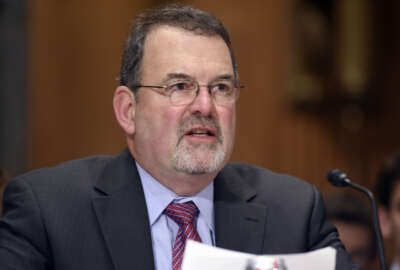
OMB stays mum on IT modernization details but promises preparedness
Federal Chief Information Officer Tony Scott shared a few more clues about the guidance and metrics of the administration's plan to modernize the government's a...
If you want to know more about the Office of Management and Budget’s plan to update federal IT systems, tell Congress to get back to work.
Federal Chief Information Officer Tony Scott said his office does have guidance ready in case Congress passes the Modernizing Government Technology Act, and is planning on releasing that guidance for public comment soon.
“We’ve been adjusting as this has gone down the road a little bit,” Scott told Federal News Radio’s Executive Editor Jason Miller, during an Oct. 13 ACT-IAC 2016 IT Modernization Forum. “We’re pretty much ready to go … unless it’s radically different than what’s on the table now, I think we’ll be ready to go actually pretty quickly. What we have now in the hopper is general guidance, not MGT specific, but the parameters and the shape of it I think are pretty well understood.”
The guidance is good, Scott said, and predicates what would need to happen to make an informed decision about updating outdated technology.
“We really do want public comment, and more input on it,” Scott said. “Then depending on where the legislation goes, finalize and then issue the final thing.”
Scott has been stumping for an IT modernization plan since the President’s budget — which included $3.1 billion for the fund — was unveiled in February.
This summer he made the call for an alternative to the fund, which was returned by four senators through the bipartisan Modernizing Obsolete and Vulnerable Enterprise IT (MOVE-IT) Act.
In September Rep. Will Hurd (R-Texas) introduced the MGT Act, which combines the two bills. It passed the House but is still in the Senate.
“As conceived, the IT modernization, now MGT fund, would accept proposals from federal agencies or collections of federal agencies working together for modernization concepts, shared infrastructure, shared services, whatever it happens to be,” Scott said. “Those will get evaluated against a predetermined set of criteria. I do imagine there will be some work that will be more top-down driven, based on who’s in the administration and they’ll say to an agency or collection of agencies this is an important area for us to go address. I’m sure some of that will get guidance from the top in terms of what the high priority set of things are.”
According to the bill’s text, an information technology modernization board will review agency proposals, It will be comprised of 8 total members, two permanent positions and six appointed positions. The two permanent positions are the federal CIO and a senior General Services Administration official.
Acting federal deputy chief information officer Margie Graves said the board that would oversee the funding would include a rotation of executives from the IT, financial and acquisition community, to get “a full spectrum of [subject matter experts] … each one of them looking through a different lens.”
“My expectation would be that we will produce some criteria before anybody produces their first business case, to guide people as to how they would bring that best forum to the table, so we can actually have that kind of discussion and make those data driven decisions,” Graves said during the forum.
Graves said GSA will have a standing role on the board, as well as a role on project execution.
“We already have a lot of experience with preparing business cases, they’re very detailed in what we’re trying to achieve, what the return on investment’s going to be over what period of time, we look at financials, we look at project work; is it additions of people, is it new IT that’s needed, is it something, for instance, to help with network services transition, and then how do we recover those costs,” said Mary Davie, GSA’s assistant commissioner for Office of Integrated Technology Services in GSA’s Federal Acquisition Service and the IT category manager. “It’s going to be a very similar process to that, with involvement from many agencies kind of looking across at what makes the most sense for the use of this fund. It’ll just depend on how that ultimately plays out.”
As far as metrics when reviewing projects, Scott said the likelihood of success does play a part in this type of approach to modernization.
“Is the proposal following the practices that we think are important, agile, and so on,” Scott said. “[Has] the management team bought in, are they really fully supportive, do they have a way to pay back the fund that’s plausible, what is their change management plan. I think you … have to look at any proposal from a bunch of different vantage points, then make a judgment call about is this the highest and best use of funding and resources that we have available.”
Copyright © 2024 Federal News Network. All rights reserved. This website is not intended for users located within the European Economic Area.
Related Stories





